Abstract
A retrospective cohort study was conducted to examine the mortality experience of 2174 men employed between 1940 and 1978 by a large chemical company and who had been assigned to a chemical production department that used or produced ethylene oxide (EO). Comparisons were made with the general United States population, the regional population, and with a group of 26,965 unexposed men from the same plants. Comparisons with general United States death rates showed fewer deaths than expected in the EO group due to all causes and for total cancers. There was no statistically significant excess of deaths due to any cause. Seven deaths each due to leukaemia and pancreatic cancer were observed with 3.0 and 4.1 deaths expected. Among the subcohort of men who worked where both average and peak exposure levels were probably highest, however, one death due to pancreatic cancer (0.9 expected) and no deaths due to leukaemia were observed. Four of the seven who died from leukaemia and six of the seven who died from pancreatic cancer had been assigned to the chlorohydrin department where the potential for exposure to EO is judged to have been low. The relative risk of death due to each disease was strongly related to duration of assignments to that department. When men who worked in the chlorohydrin department were excluded, there was no evidence for an association of exposure to EO with pancreatic cancer or leukaemia. Together with the failure to show independent EO associations, the chlorohydrin department results suggest that leukaemia and pancreatic cancer may have been associated primarily with production of ethylene chlorohydrin or propylene chlorohydrin, or both. These results emphasise the importance of examining additional concurrent/asynchronous exposures among human populations exposed to EO.
Full text
PDF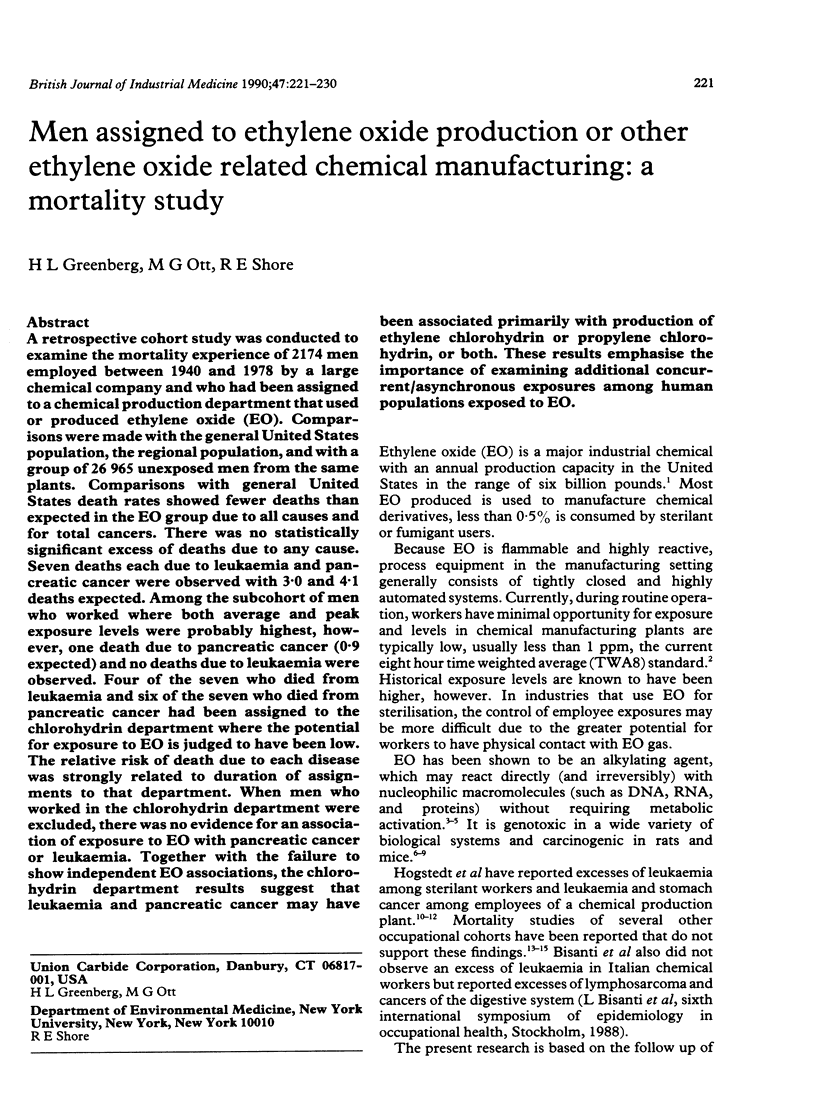
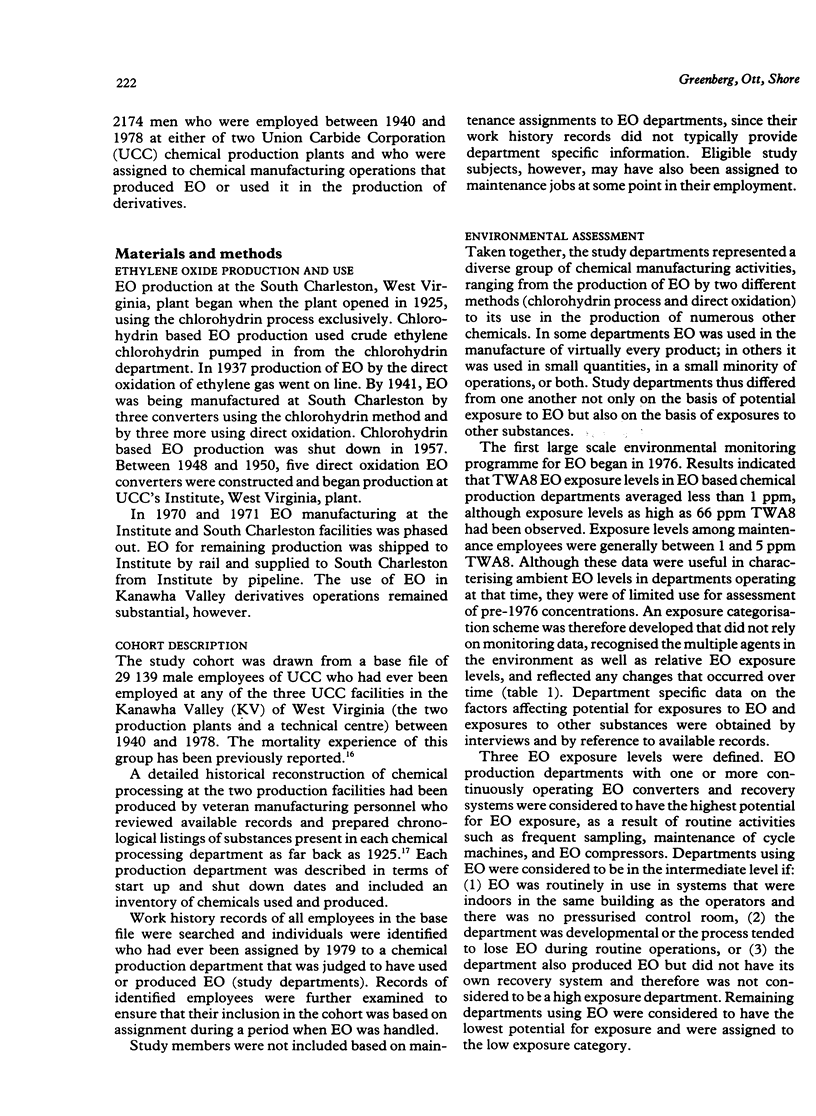
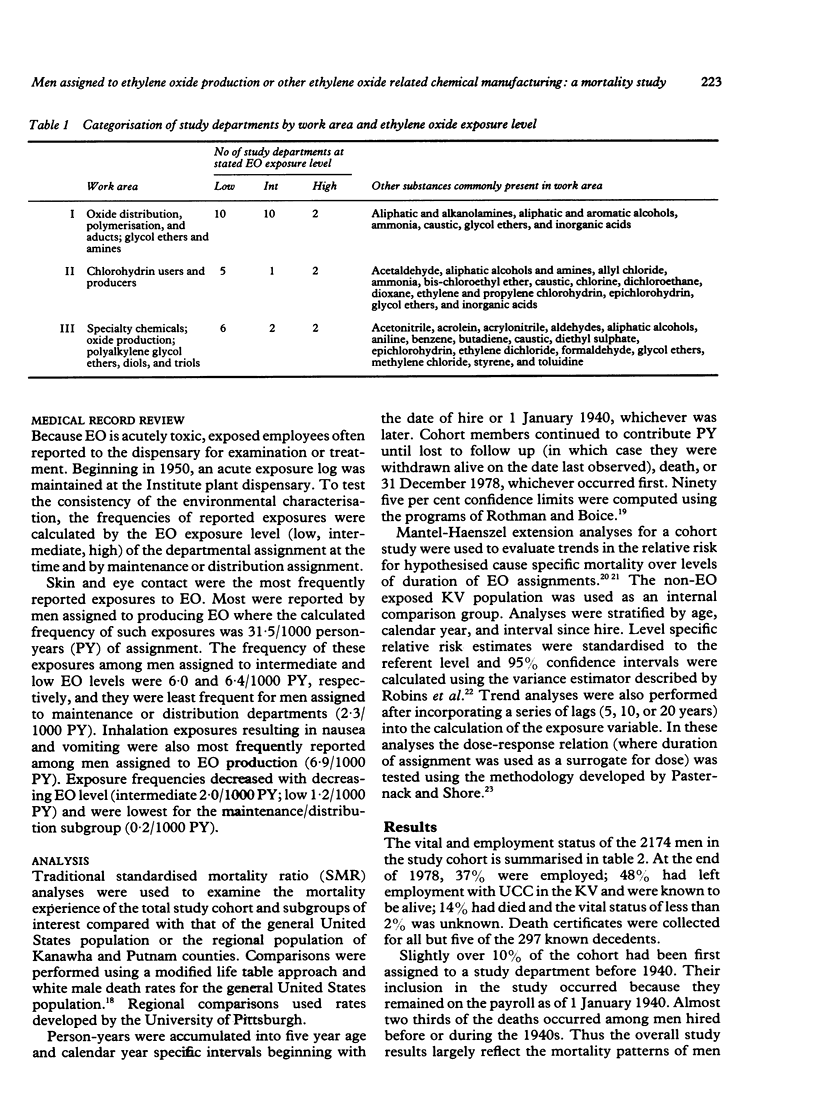
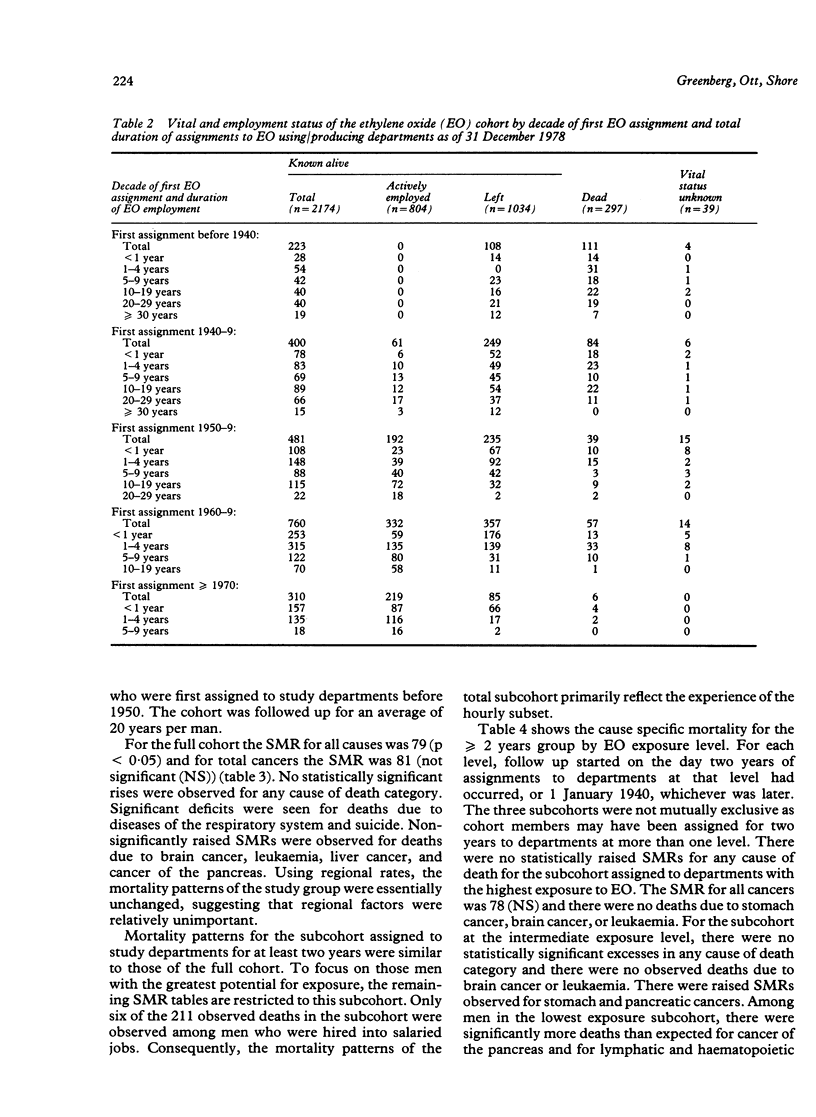

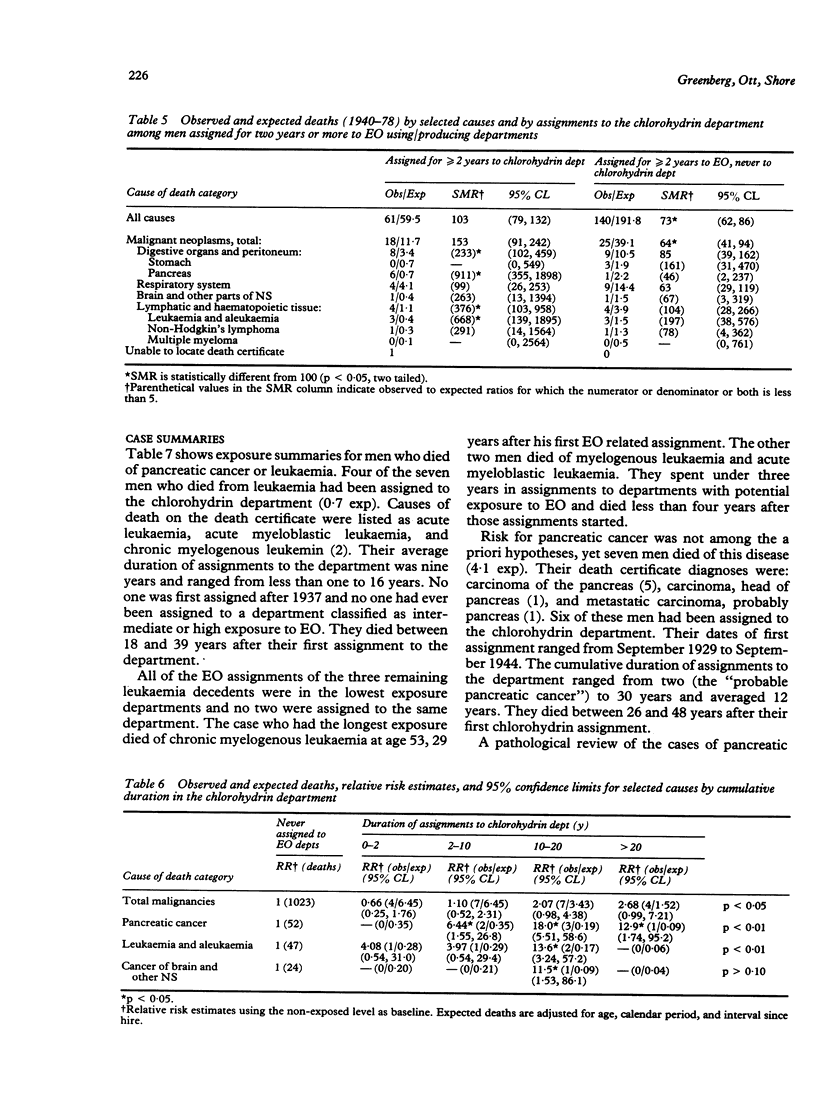
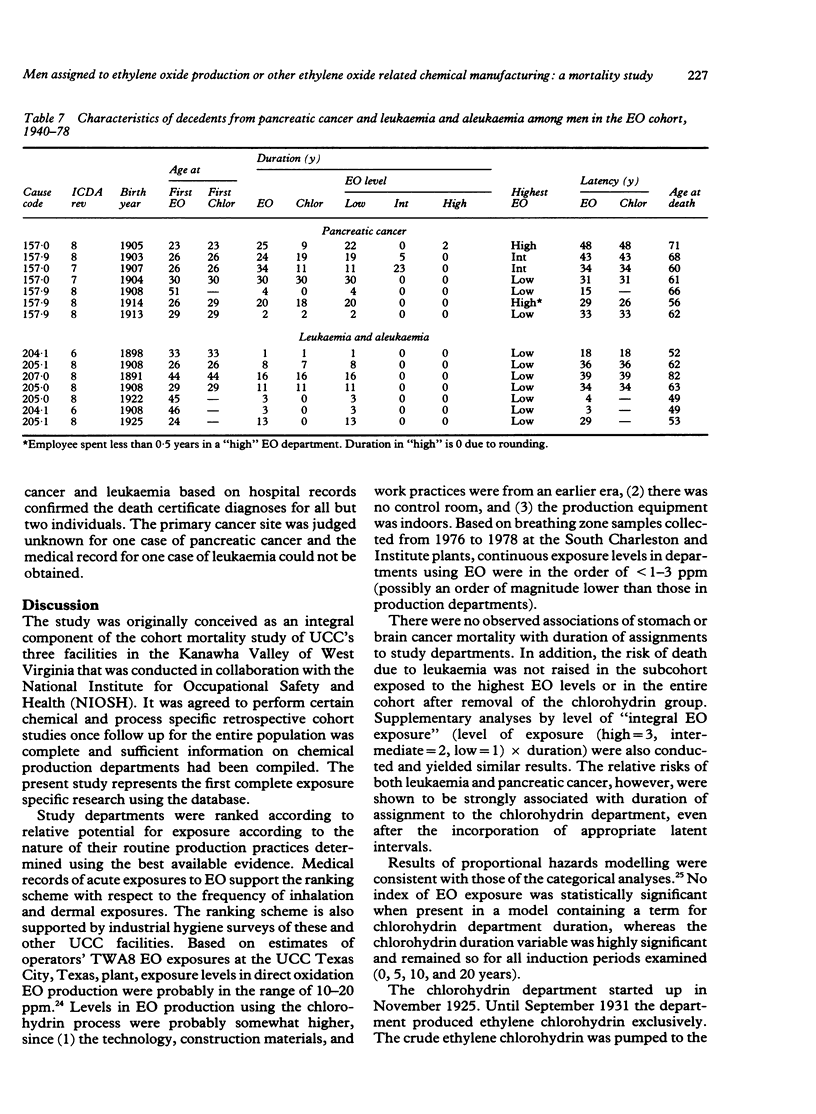
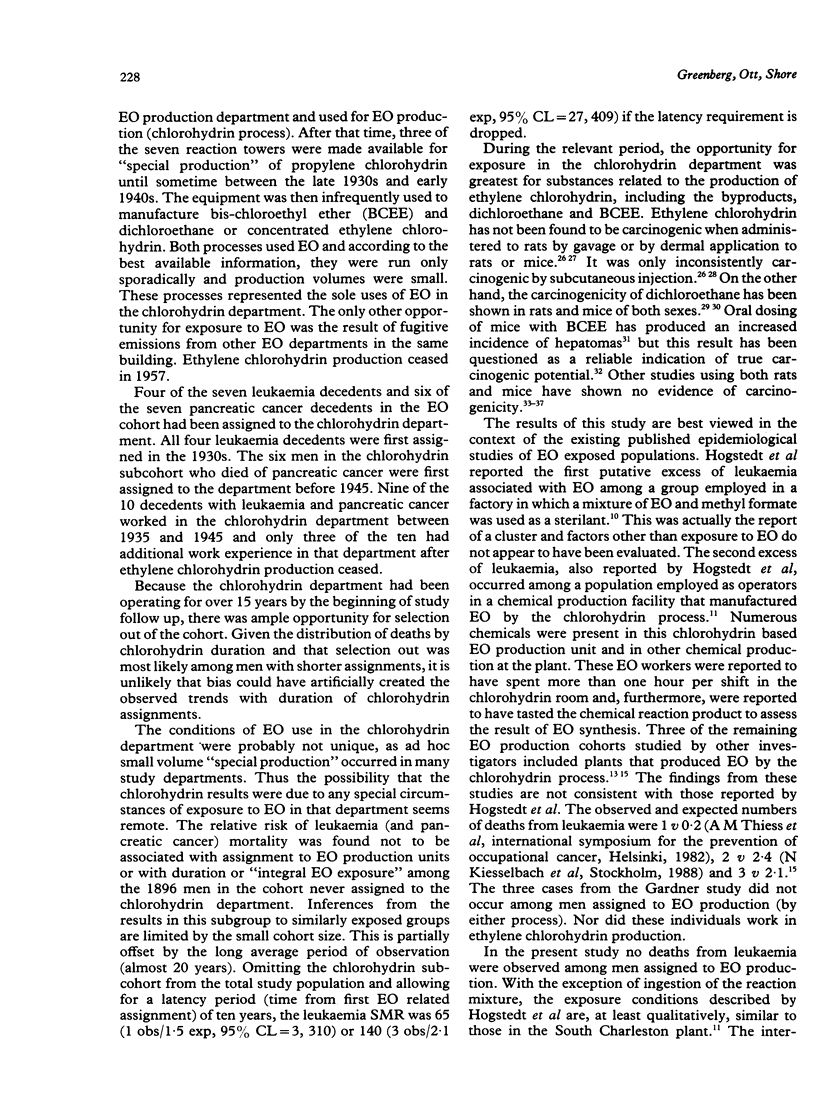
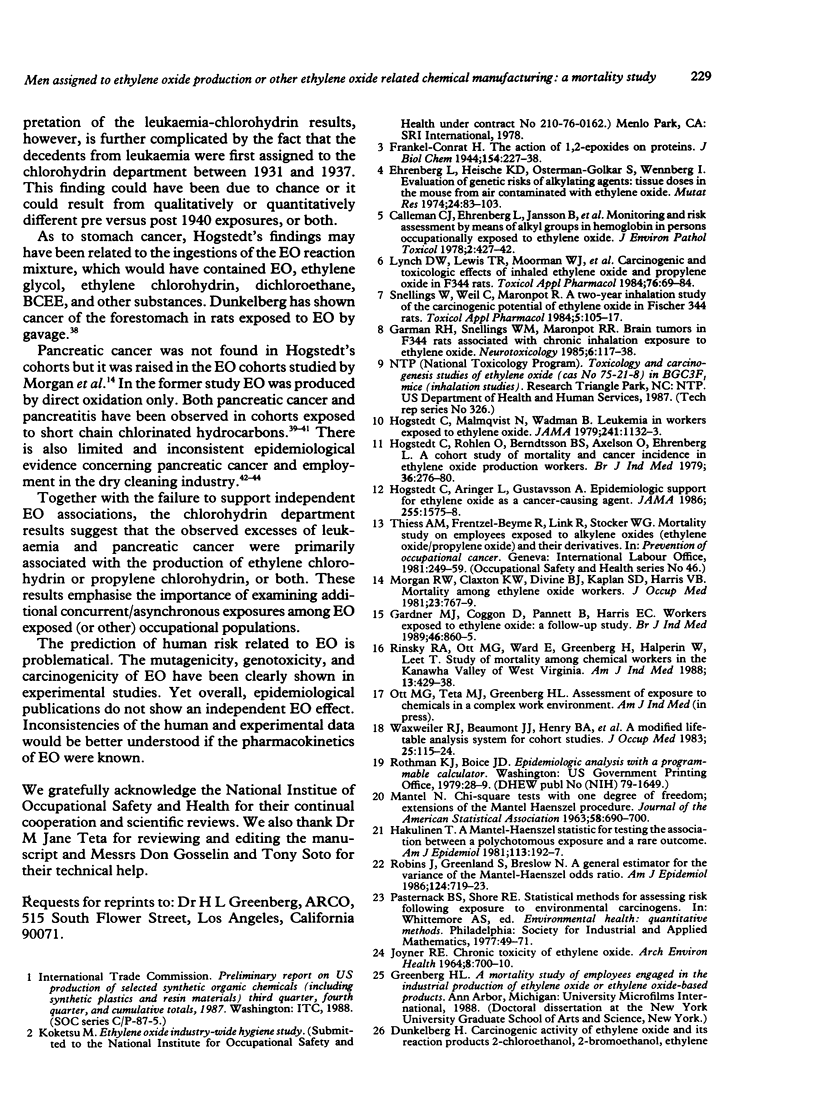
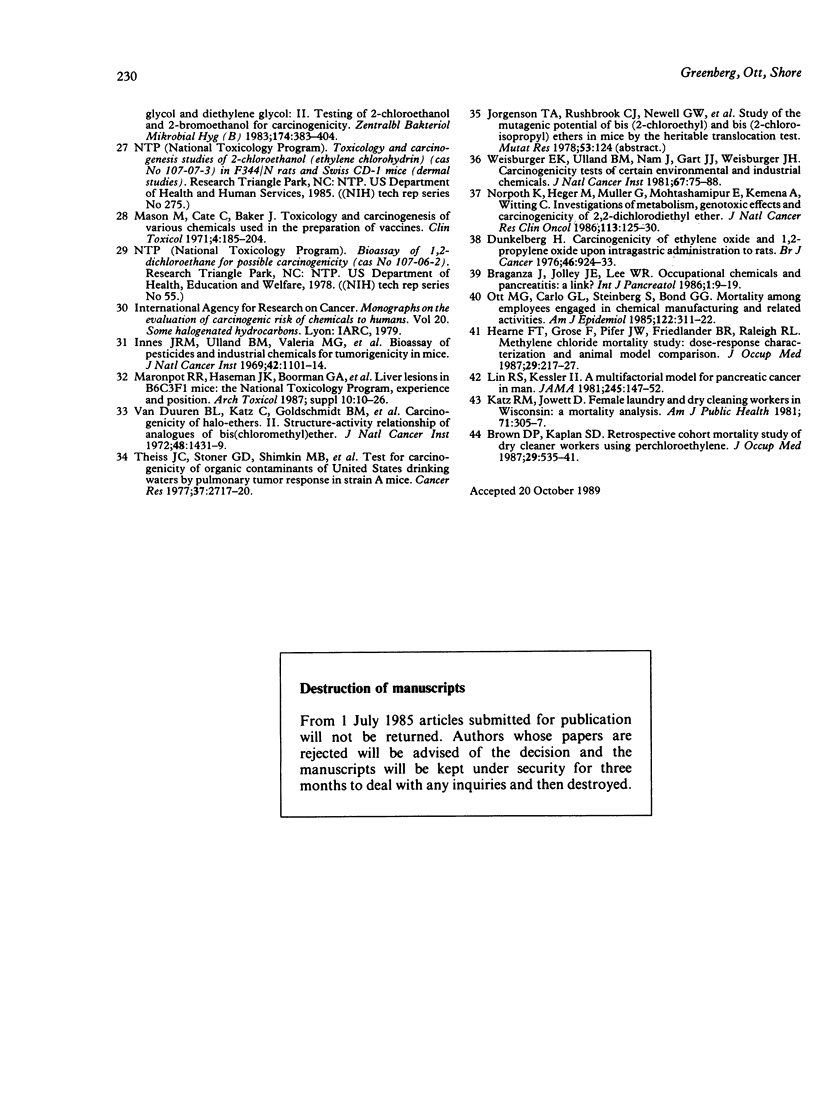
Selected References
These references are in PubMed. This may not be the complete list of references from this article.
- Braganza J. M., Jolley J. E., Lee W. R. Occupational chemicals and pancreatitis: a link? Int J Pancreatol. 1986 May;1(1):9–19. doi: 10.1007/BF02795235. [DOI] [PubMed] [Google Scholar]
- Brown D. P., Kaplan S. D. Retrospective cohort mortality study of dry cleaner workers using perchloroethylene. J Occup Med. 1987 Jun;29(6):535–541. [PubMed] [Google Scholar]
- Calleman C. J., Ehrenberg L., Jansson B., Osterman-Golkar S., Segerbäck D., Svensson K., Wachtmeister C. A. Monitoring and risk assessment by means of alkyl groups in hemoglobin in persons occupationally exposed to ethylene oxide. J Environ Pathol Toxicol. 1978 Nov-Dec;2(2):427–442. [PubMed] [Google Scholar]
- Dunkelberg H. Carcinogenicity of ethylene oxide and 1,2-propylene oxide upon intragastric administration to rats. Br J Cancer. 1982 Dec;46(6):924–933. doi: 10.1038/bjc.1982.303. [DOI] [PMC free article] [PubMed] [Google Scholar]
- Dunkelberg H. Kanzerogene Aktivität von Ethylenoxid und seinen Reaktionsprodukten 2-Chlorehtnaol, 2-Bromethanol, Ethylenglykol und Diethylenglykol. I. Kanzerogenität von Ethylenoxid im Vergleich zu 1,2-Propylenoxid bei subkutaner Applikation an Mäusen. Zentralbl Bakteriol Mikrobiol Hyg B. 1981 Dec;174(5):383–404. [PubMed] [Google Scholar]
- Ehrenberg L., Hiesche K. D., Osterman-Golkar S., Wenneberg I. Evaluation of genetic risks of alkylating agents: tissue doses in the mouse from air contaminated with ethylene oxide. Mutat Res. 1974 Aug;24(2):83–103. doi: 10.1016/0027-5107(74)90123-7. [DOI] [PubMed] [Google Scholar]
- Gardner M. J., Coggon D., Pannett B., Harris E. C. Workers exposed to ethylene oxide: a follow up study. Br J Ind Med. 1989 Dec;46(12):860–865. doi: 10.1136/oem.46.12.860. [DOI] [PMC free article] [PubMed] [Google Scholar]
- Garman R. H., Snellings W. M., Maronpot R. R. Brain tumors in F344 rats associated with chronic inhalation exposure to ethylene oxide. Neurotoxicology. 1985 Spring;6(1):117–137. [PubMed] [Google Scholar]
- Hakulinen T. A Mantel-Haenszel statistic for testing the association between a polychotomous exposure and a rare outcome. Am J Epidemiol. 1981 Feb;113(2):192–197. doi: 10.1093/oxfordjournals.aje.a113083. [DOI] [PubMed] [Google Scholar]
- Hearne F. T., Grose F., Pifer J. W., Friedlander B. R., Raleigh R. L. Methylene chloride mortality study: dose-response characterization and animal model comparison. J Occup Med. 1987 Mar;29(3):217–228. [PubMed] [Google Scholar]
- Hogstedt C., Aringer L., Gustavsson A. Epidemiologic support for ethylene oxide as a cancer-causing agent. JAMA. 1986 Mar 28;255(12):1575–1578. [PubMed] [Google Scholar]
- Hogstedt C., Malmqvist N., Wadman B. Leukemia in workers exposed to ethylene oxide. JAMA. 1979 Mar 16;241(11):1132–1133. [PubMed] [Google Scholar]
- Hogstedt C., Rohlén O., Berndtsson B. S., Axelson O., Ehrenberg L. A cohort study of mortality and cancer incidence in ethylene oxide production workers. Br J Ind Med. 1979 Nov;36(4):276–280. doi: 10.1136/oem.36.4.276. [DOI] [PMC free article] [PubMed] [Google Scholar]
- Innes J. R., Ulland B. M., Valerio M. G., Petrucelli L., Fishbein L., Hart E. R., Pallotta A. J., Bates R. R., Falk H. L., Gart J. J. Bioassay of pesticides and industrial chemicals for tumorigenicity in mice: a preliminary note. J Natl Cancer Inst. 1969 Jun;42(6):1101–1114. [PubMed] [Google Scholar]
- JOYNER R. E. CHRONIC TOXICITY OF ETHYLENE OXIDE. A STUDY OF HUMAN RESPONSES TO LONG-TERM LOW-LEVEL EXPOSURES. Arch Environ Health. 1964 May;8:700–710. doi: 10.1080/00039896.1964.10663741. [DOI] [PubMed] [Google Scholar]
- Katz R. M., Jowett D. Female laundry and dry cleaning workers in Wisconsin: a mortality analysis. Am J Public Health. 1981 Mar;71(3):305–307. doi: 10.2105/ajph.71.3.305. [DOI] [PMC free article] [PubMed] [Google Scholar]
- Lin R. S., Kessler I. I. A multifactorial model for pancreatic cancer in man. Epidemiologic evidence. JAMA. 1981 Jan 9;245(2):147–152. [PubMed] [Google Scholar]
- Lynch D. W., Lewis T. R., Moorman W. J., Burg J. R., Groth D. H., Khan A., Ackerman L. J., Cockrell B. Y. Carcinogenic and toxicologic effects of inhaled ethylene oxide and propylene oxide in F344 rats. Toxicol Appl Pharmacol. 1984 Oct;76(1):69–84. doi: 10.1016/0041-008x(84)90030-9. [DOI] [PubMed] [Google Scholar]
- Maronpot R. R., Haseman J. K., Boorman G. A., Eustis S. E., Rao G. N., Huff J. E. Liver lesions in B6C3F1 mice: the National Toxicology Program, experience and position. Arch Toxicol Suppl. 1987;10:10–26. doi: 10.1007/978-3-642-71617-1_2. [DOI] [PubMed] [Google Scholar]
- Morgan R. W., Claxton K. W., Divine B. J., Kaplan S. D., Harris V. B. Mortality among ethylene oxide workers. J Occup Med. 1981 Nov;23(11):767–770. doi: 10.1097/00043764-198111000-00011. [DOI] [PubMed] [Google Scholar]
- Rinsky R. A., Ott G., Ward E., Greenberg H., Halperin W., Leet T. Study of mortality among chemical workers in the Kanawha Valley of West Virginia. Am J Ind Med. 1988;13(4):429–438. doi: 10.1002/ajim.4700130403. [DOI] [PubMed] [Google Scholar]
- Robins J., Greenland S., Breslow N. E. A general estimator for the variance of the Mantel-Haenszel odds ratio. Am J Epidemiol. 1986 Nov;124(5):719–723. doi: 10.1093/oxfordjournals.aje.a114447. [DOI] [PubMed] [Google Scholar]
- Snellings W. M., Weil C. S., Maronpot R. R. A two-year inhalation study of the carcinogenic potential of ethylene oxide in Fischer 344 rats. Toxicol Appl Pharmacol. 1984 Aug;75(1):105–117. doi: 10.1016/0041-008x(84)90081-4. [DOI] [PubMed] [Google Scholar]
- Theiss J. C., Stoner G. D., Shimkin M. B., Weisburger E. K. Test for carcinogenicity of organic contaminants of United States drinking waters by pulmonary tumor response in strain A mice. Cancer Res. 1977 Aug;37(8 Pt 1):2717–2720. [PubMed] [Google Scholar]
- Van Duuren B. L., Katz C., Goldschmidt B. M., Frenkel K., Sivak A. Carcinogenicity of halo-ethers. II. Structure-activity relationships of analogs of bis(chloromethyl)ether. J Natl Cancer Inst. 1972 May;48(5):1431–1439. [PubMed] [Google Scholar]
- Waxweiler R. J., Beaumont J. J., Henry J. A., Brown D. P., Robinson C. F., Ness G. O., Wagoner J. K., Lemen R. A. A modified life-table analysis system for cohort studies. J Occup Med. 1983 Feb;25(2):115–124. [PubMed] [Google Scholar]
- Weisburger E. K., Ulland B. M., Nam J., Gart J. J., Weisburger J. H. Carcinogenicity tests of certain environmental and industrial chemicals. J Natl Cancer Inst. 1981 Jul;67(1):75–88. [PubMed] [Google Scholar]


